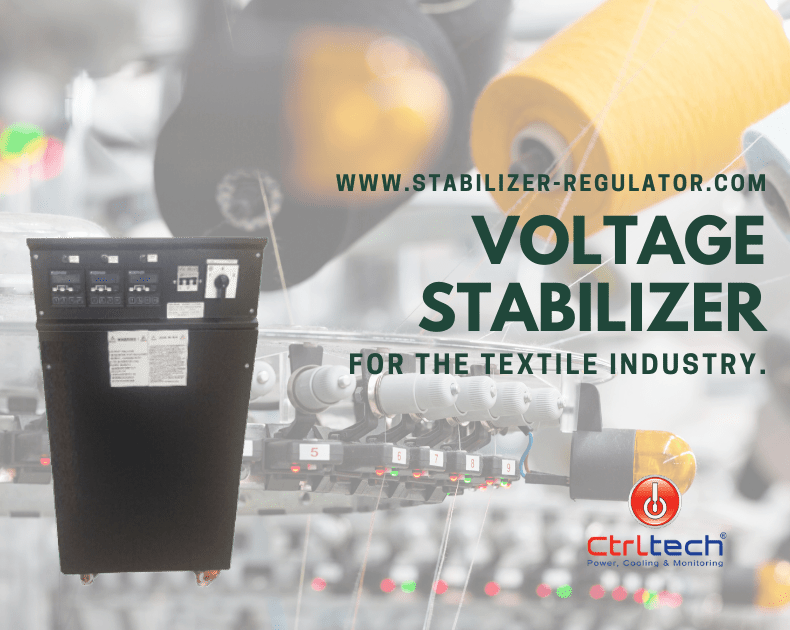Textile machine voltage stabilizer.
Textile production factories around the world are part of the major industry of many countries economies. It is primarily reliant on the transformation of fiber into yarn, which is subsequently converted into fabric. These are then colored or printed, then manufactured into cloth, later turned into usable objects like clothes, home items, furniture, and different industrial applications. Textile factories use many electrical and electronics loads. And this page is going to explain how to use voltage regulators to these machines from voltage surges.

Textile industry.
A variety of different fibers are used to make yarns. Cotton is the essential natural fiber; thus, it is given special attention. The complexity of the finishing and coloration processes, along with the various varied procedures accessible at the spinning and fabric-forming stages, result in the manufacture of a vast range of goods.
Most textile machinery is located in a cotton-dusty, humid environment. Hence, voltage regulators are typically needed to be near textile equipment. Our company’s textile equipment voltage stabilizer uses the construction of a sealing inner air duct board. For emitting heat, an auto temperature test control is used. The whole system is moisture-proof to guarantee that equipment continues to operate generally in high-humidity environments. Our voltage regulators offer high voltage regulation precision, excellent stability, and faultless protection.
Why should you get voltage regulators for the textile industry?
Textile machinery is delicate, and they work in extreme environments. Therefore, it is essential to provide proper working conditions to them and ensure their functionality at all times. Even if there is a slight variation in the supplied voltage, the machinery that you use in the textile industry can be subjected to damages. A voltage regulator can assist you in staying away from encountering all sorts of similar issues.
Voltage drops result from various reasons like feeder length, increased load density, and transmission losses. Frequently switching on and off of heavy load, adding new loads, and daily and seasonal changes in load profiles cause current fluctuations. On the other hand, electrical equipment used in the textile industry has power quality requirements that need a consistent voltage despite fluctuations in load current. Unregulated voltage can cause lights brownouts, overheat, decrease motor life, and cause electronics to break prematurely.
Textile machines are more vulnerable to voltage fluctuations due to the extreme environmental conditions they are subjected to. In other words, you will have to take extraordinary measures to ensure their protection in humid and cotton-dusty conditions. When constant-voltage is supplied, you can ensure that they don’t emit heat unnecessarily. It can benefit machinery, as they are not designed to handle spikes of heat.
Voltage regulators for power distribution overcome the voltage drop problem by maintaining line voltage within specified limits, allowing lights, appliances, and motors to operate correctly. At the same time, the basic function of a power distribution voltage stabilizer is to deliver controlled voltage. And it fulfills power quality requirements; electronic controls for voltage regulators can also provide conservation voltage reduction, metering, and integrated voltage control. This will eventually help textile machinery ensure its proper functionality and help you get the desired outcome.
How can voltage regulators protect textile machinery?
Voltage regulators for power distribution systems keep system voltages within a set range. Voltage regulation ensures that electrical goods and equipment perform at their best. Hence, getting a voltage regulator is a wise decision that you can take to better your facility. The voltage stabilizer will regulate voltage before it is fed to the textile machinery that you use. Hence, you can make sure that all textile machinery ensures its proper function in the long run.
Typically, electrical goods and equipment, including textile machinery, are intended to work within a specific voltage range. Voltage regulation that isn’t up to par might cause equipment to operate poorly. Damage to electronics, poor motor functioning, weak light bulbs, and various other problems can occur when you provide voltage with spikes to textile machinery. It is why it is a good idea to invest in textile machinery at all times.
System voltages are dragged down by heavy electrical loads and lengthy distribution lines. Voltage regulators allow utilities to keep voltage levels within safe limits, providing utility consumers peace of mind that their electrical equipment will function correctly.
Not all voltage stabilizers available out there would not be appropriate for machinery that you have. It is why it is essential to look for the most suitable voltage regulator and start using it. Then you can keep peace of mind, as you are receiving intended functionality out of all textile machinery. Always take a look at higher load ratings, vacuum technology, and reduced maintenance requirements as you buy voltage stabilizers for the textile industry.